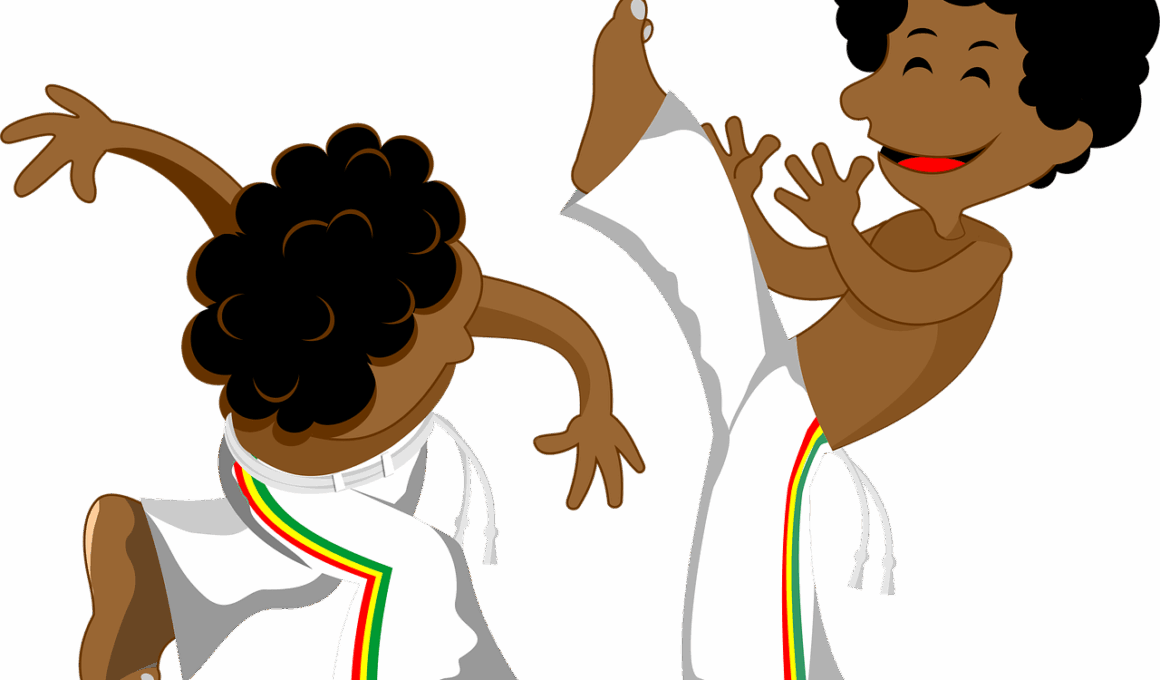The Role of Rhythm and Music in Capoeira Self-Defense Training
Capoeira is more than just a martial art; it is a unique blend of movement, culture, and music that promotes self-defense techniques. Originating in Brazil, Capoeira embodies rhythm and music as fundamental elements in its practice. The combination of these elements does not only enhance physical fitness but also sharpens mental agility and coordination. Understanding the importance of rhythm allows practitioners to anticipate and respond to their opponents effectively. In Capoeira, the music serves as a guide, helping practitioners synchronize their movements in a fluid yet effective manner. The beats of the berimbau, a traditional instrument used in Capoeira, dictate the pace and style of the fight. Moreover, the cultural chants associated with Capoeira instill a sense of unity among participants. Through rhythmic training, students develop a keen sense of timing and spatial awareness that enhances their self-defense capabilities. Thus, the interplay of music and movement is crucial for developing techniques that are not only powerful but also aesthetically pleasing. This harmonious connection has made Capoeira a celebrated practice worldwide, transcending the limitations of traditional self-defense training.
Empowerment through Movement and Music
Incorporating rhythm and music into self-defense training through Capoeira empowers practitioners in multiple ways. The essential quality of rhythm boosts confidence as students engage in challenging movements to beats from traditional instruments. When individuals move in sync with music, they are able to express themselves and unleash their creativity. This influence of music extends beyond the physical realm, impacting emotional states and overall morale. In intense situations, the presence of rhythm can act as a calming influence, enabling practitioners to center their thoughts while executing defensive maneuvers. Additionally, exploring various musical styles can expose learners to diverse cultural backgrounds, enriching their Capoeira experience. Practicing Capoeira does not only build skills for physical combat but also cultivates community and emotional resilience. The act of training within a group, guided by rhythms, promotes collaboration and trust among participants. As they learn to rely on their peers and navigate the coordinated movements, individuals develop essential interpersonal skills. Ultimately, this fusion of empowerment through movement and music can enhance personal growth and self-defensive capabilities overall.
Capoeira’s music plays a vital role in creating an immersive training environment. The diverse array of musical sounds, from the sharp notes of the berimbau to the energetic rhythm of drums, provides an inspiring backdrop for practice. This stimulating atmosphere encourages students to push their limits and explore new techniques while establishing a connection with their martial art. The melodies can evoke various emotions, from excitement to focus, influencing how practitioners approach each training session. Moreover, the music contributes to memory retention, making it easier to recall specific techniques during high-stress situations. As practitioners memorize choreographed movements in line with music, their learning process becomes more engaging and enjoyable. The auditory cues also serve to synchronize group training, ensuring all participants move as a cohesive unit. In crowded training spaces, this musical synchronization provides fluidity, enhancing safety and minimizing accidents. Overall, Capoeira training utilizing rhythmic music fosters a productive training environment that supports mental and physical development. Ultimately, the relationship between rhythm and self-defense teaches practitioners to respond dynamically, making them more capable of handling real-world scenarios.
Building Reaction Time with Rhythm
Another essential aspect of the role of rhythm in Capoeira self-defense training lies in enhancing reaction times. Practicing among musical beats sharpens reflexes and helps practitioners learn to adapt swiftly to changing scenarios. Within a training context, increasing rhythmic complexity assists students in developing advanced timing and coordination skills. As participants perform techniques to syncopated beats, they become more attuned to interpreting their opponents’ movements, which is crucial for effective self-defense. Furthermore, rhythmic training fosters a heightened sense of awareness of oneself and one’s surroundings, leading to improved instinctive responses. When under stress, this greater awareness enables practitioners to adapt to dynamic situations more effortlessly. Moving in rhythm not only enhances physical mechanics but also refines the mind-body connection necessary for defending oneself effectively. This training approach empowers students to remain composed under pressure, setting them up for success both in Capoeira practice and real-life situations. Thus, rhythm serves as a vital tool for creating adaptive fighters and self-defense experts who can navigate various encounters fluidly.
Capoeira’s unique emphasis on music also serves to foster a stronger sense of community among practitioners. The social aspect of Capoeira is evident during training sessions, where collaborative learning occurs in a supportive environment that encourages growth. As students participate in group drills and demonstrations, the shared rhythm of music builds camaraderie. These social bonds play an essential role in developing trust and boosting confidence in each other’s abilities. Additionally, as participants engage in playful interactions, they learn to appreciate the unpredictable nature of fighting. The interactions foster resilience and adaptability essential for practitioners’ development. Furthermore, the musical component encourages everyone to support one another through a vibrant and engaging atmosphere. In this context, students share experiences and cultivate friendships, reinforcing the sense of belonging. Regularly coming together in a shared rhythm encourages lasting relationships that extend beyond training sessions, helping participants feel connected and supported. Consequently, the role of rhythm and music in Capoeira does not just enhance self-defense skills; it cultivates a robust community that uplifts its members and fosters personal development.
Rhythm in Sparring and Real Scenarios
During sparring sessions in Capoeira, the influence of music becomes even more pronounced. As practitioners engage in playful combat, they often find themselves moving according to the rhythm of the music that permeates the training environment. This rhythmic influence can alter the dynamics of sparring, as students learn to navigate space and time intuitively. The instinctive connection to the beat allows them to anticipate their partner’s actions, leading to smoother transitions between attack and defense. In real-life self-defense situations, this fluidity becomes invaluable, aiding in the rapid assessment and response to threats. Moreover, practicing movement patterns consistent with rhythmic beats instills a level of comfort that can translate into better performance in high-pressure scenarios. Regular sparring accompanied by music can build the confidence necessary to execute techniques swiftly and decisively when faced with unexpected challenges. Ultimately, the combination of rhythm and sparring prepares Capoeira practitioners not only for training but also equips them with the skills to protect themselves effectively should a situation arise outside of the training hall.
In conclusion, the interplay of rhythm and music in Capoeira self-defense training enriches the overall experience while enhancing essential skills. The rhythmic foundations of Capoeira foster improved physical abilities, reaction times, and mental focus. Music offers a powerful tool, not only guiding movement but also instilling a sense of unity among practitioners. Engaging with rhythm fosters creativity and emphasizes adaptability, key attributes in mastering self-defense. As participants learn through rhythmic expression, they develop resilience and confidence that translate beyond martial arts into everyday situations. The community aspect rooted in shared musical experiences nurtures lasting relationships and support networks among practitioners. Ultimately, it is clear that rhythm and music are not merely decorative features of Capoeira; they are fundamental components that shape the training process, empowering individuals to become better fighters while cultivating valuable life skills. Thus, embracing the rhythms in Capoeira helps forge stronger connections among practitioners while preparing them for both personal and physical challenges, making Capoeira a transformative journey.


